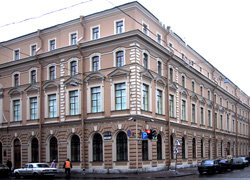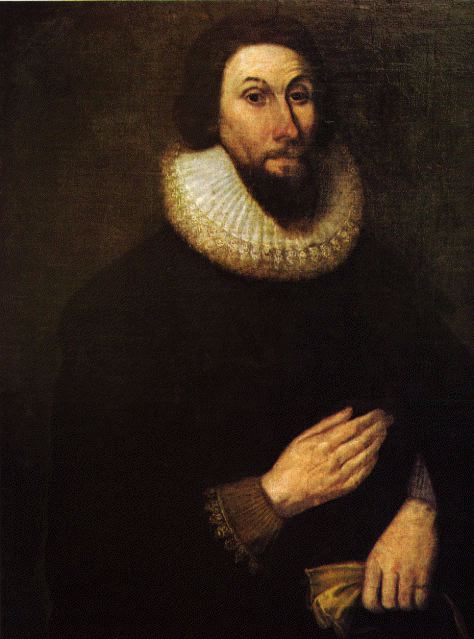
A report by Paul Zahl about a strange, haunted museum in St. Petersburg, Russia:
This past August, I slipped away for an afternoon from the tour group I
was helping to lead in Russia and the Baltics. I slipped away in order
to see a weird museum in St. Petersburg.
I had heard heard of it before, and its original form under the
Soviets, the notorious Museum of Atheism. Until a few years ago,
Russian young people used to be taken to the former St. Isaac's
Cathedral in Leningrad/Petrograd/St. Petersburg to witness a
State-operated exhibition displaying the folly, ignorance, and
wickedness of Christianity, with side-exhibits on Buddhism, Animism,
Judaism, Islam, and the Greek and Roman Gods.
After perestroika, the Museum was dismantled and St. Isaac's became a
Russian Orthodox cathedral again. The exhibits persist, however, in
a big old gray crate of a building about three blocks away. To visit
the 'Museum of Religion' today, is to have a fascinating window on the
Soviet assault on religion, in general, and Christianity, in
particular. And there is a lot to say about this, in that a whole new
generation of Western atheists would love this place, with its
overwhelming assumption that religion is a matter of competing
belief-systems with no judgments possible concerning the possible
truth-superiority of one system over against any another.
I could go on about the sociological, cultural, and even the
theological implications of St. Petersburg's Museum of Religion in the
Year of Our Lord 2009. But that's not what really drew me to the
Museum.
What drew me to the Museum of Religion, located three blocks away from
its original Russian Orthodox/Stalinist home, were the visuals, the
absurd visuals, which I hoped, and guessed, would be there.
And they were there!
You pay your entrance fee and immediately notice that there are five
times more guards in this museum than there are visitors. Once, Soviet
'confirmation' classes would have crowded the place, together with
masses of foreign tourists bussed over. Today there is no one there at
all. Today's Museum of Religion is not deemed as interesting as
yesterday's Museum of Atheism. But it's the same material.
You go up a tiny staircase — have to be pointed in the right direction
by one of the half-dozen guards who are looking at you like fresh meat
— and then enter a series of small rooms that display the Origin of
Christianity and move directly into a series of four or five rooms on
Russian Orthodoxy. None of the guards spoke English, but one of them
spoke German so I got the lay of the land from her. The room on Jesus
emphasized his teachings, with a small dose of messianism. In each
small room concerning Orthodoxy, paintings of episodes in Russian
Orthodox history were set up, together with liturgical vessels and
altar crosses and vestments. There was a mannequin of an Orthodox
priest — really ragged and dusty and gross. There was an amazing
painting of an Orthodox monk wandering in the snow looking like a
character from one of the “Blind Dead” movies as abducted by aliens, a
green Village of the Damned gleam streaming from both of his eyes.
This is the Tolstoyan religious hermit depicted as insane man.
There was another shocking painting nearby, from around the time of the
1905 Revolution (i.e., the time of The Battleship Potemkin), depicting Nicholas and
Alexandra protected by a holy beam of light coming down from Christ and
the Father and Mary in heaven. The Tsar and Tsarina are surrounded by
priests and martyrs, who are being shot at by squads of Reds, who are
in turn being given money by Jews. The image is shocking and violent,
and also apocalyptic.
Interestingly to me as a Christian, one item in the rooms dedicated to
Russian Orthodoxy stood out with a moving and unquestionable
intensity. It is a marble statue, about four feet high, of Jesus naked
and bound, being led to his crucifixion. He is muscular and intrepid,
but helplessly under restraint. It is a beautiful image. It leaped out
of its “wax museum” surroundings.
Incidentally, I kept thinking of Professor Lampini's “Chamber of
Horrors” in House of Frankenstein, and also of Will Rogers' hay-seed
wax museum of American heroes in Steamboat 'round the Bend. The people
who assembled the Russian exhibit on religion probably didn't know
much about what they were exhibiting, except that it all needed to be
as ugly as possible. To see it in the Summer of 2009, now tatty in the
extreme, and filthy, is extremely cool.
But wait, I'm not finished. The Museum has a section on
Protestantism. Behold, another manikin!: this time, of a “Reformed
Pastor”. But it's mistaken. The cassock is right, and the preaching
tabs, but the figure is wearing a large pectoral cross. Reformed
ministers, at least until very recently, have not worn crosses around
their necks. Heaven forfend! And there's a Hogarth engraving of an
18th Century church that has the complete wrong title. On the other
hand, the “attitude” of the exhibit is nowhere near as vehement in
relation to Protestantism as it is in relation to the Russian National
Church. Protestantism comes across as being a rare and relatively
enlightened bird.
Speaking of birds, the room on Animism is great. There is a statue of
a big black bird, I think a Polynesian deity, with yellow and red
feathers. They are coming unglued, so you start to sneeze as soon as
you enter the room. But there are no other visitors to hear you or
notice. Since I had brought no Kleenex, I was glad to be sneezing
alone. One of the feathers that had come off and was lying on the
floor was too small to be of any aid.
One final item, and then a postscript. The attempt at constructing a
Buddhist meditation area or temple — no words can do this justice —
was delightful. There were a couple of small statues of the Buddha, on
a wooden platform about six inches off the ground in the center of the
room. Overhead were a couple of scarves or pashminas, intended to be
drapes, but they were blowing in the wind because the Museum's fans
were on. That was it. I was just wishing for a little background
music by Enigma.
All in all, the Museum of Religion in St. Petersburg is a relic of
fascinating persistence in the aftermath of an historical earthquake in
Russia, and in the world even. Is it anti-religious? Well, yes, as
the attitude is that of competing, fantastic, and anthropomorphic
attempts to represent the Unrepresentable. It reflects what religious
studies departments in American universities used to call “phenomenology”, which is the idea that religion has got to be studied
purely in relation to its surface manifestations, rather than in
relation to the possibility of actual or possible transcendence. So
yes, the Museum of Religion is anti-religious.
But it is also a Museum which has been demoted. It is definitely not
the Museum of Atheism. The cue cards to each room, which my
unrehearsed and unexpected guide explained to me in German, try to
sound objective. But they are just reporting on what fools these
mortals be. (Oh, and only in the room devoted to the French Revolution
does the visual material really go over the top, and this in its
satirizations of Roman Catholicism. In this room, we are really in the
spirit of Robespierre and 1793.)
What appealed to me primarily in this messy nut-house of an exhibit
hall was its absurdity — the misconceived manequin of a Presbyterian
clergyman, the feathers-and-all large Polynesian bird (looking like the
monster in The Giant Claw), the hagiographic and extreme-polemical
painting of the martyred Nicholas and Alexandra, and the sudden
overwhelming appearance of the real thing: Jesus in white marble,
bound, humble, decided, suffering, pitying and to be pitied yet
wordlessly strong. The “camp” value of the place, which is out of
Billy Wilder's One Two Three (remember “We Have No Bananas” in
Russian?), is high. The sadness of its exhibits with many more warders
than visitors is also pathetic in the real sense. And yet the flashes
of insight, both negative to organized religion and positive to bound
martyrs — and hermits of the forest — are really there.
I left, a little bewildered, a little amused,
a little moved, as I said “Auf wiedersehen!” to my new Russian
guard/guide, who may have picked up her German during the Siege of
Leningrad. I thought to myself: this is the kind of thing that the SS envisioned when they
gave orders that the Jewish Ghetto in Prague be turned into an open-air
museum after its inhabitants had been liquidated — a “time-capsule” of
a vanished people and a vanished way of life, which people of the
future could inspect and wonder at. Today, however, the Ghetto in
Prague is the symbol of an entirely different kind of confidence, and
the tables are turned utterly. I thought these things as I heard the
bells of St. Isaac's, just three blocks away, and observed the hundreds
and hundreds of people crowding to get in — and not just tourists from
overseas, but Russian citizens. As Jack Kerouac said, “The world is
big enough to right itself.”
Postscript
If you enjoyed this piece, go over to YouTube and connect with Sergei
Eisenstein's silent film of 1927 entitled October. It is also called
Ten Days That Shook the World. In the fourth segment of the YouTube
version, when General Kornilov's army is approaching St. Petersburg,
Eisenstein creates a montage on the theme of God. When the soldiers
are being enjoined, by reactionaries, to fight “For God and for the
State”, the director edits together a series of images of God.
He starts with Jesus; then goes to the mosque in St. Petersburg, which
still looks like it did when Eisenstein's photographer Edward Tisse
shot it in the silent era; then shows the Buddha, incense billowing
around him this time, not a pashmina; then our Polynesian Giant Claw (I
really think it's the same statue.); then some tribal African statues;
then some spooky dangling hands from one of those statues; then a few
really horrible and very Pagan religious images. There it is! In
Eisenstein's film exists the direct origin of the now staggeringly
retro Museum of Religion. That's what it was really all about: a
frontal and absolute ideological rejection of religion as being
anything other than competing disasters of projection and morbidity,
carrying the planetary virus of idolatry — religion as systematic
put-down of the humanity of the human race.
I want to tell Richard Dawkins and Sam Harris about this movie, not to
mention this museum.




